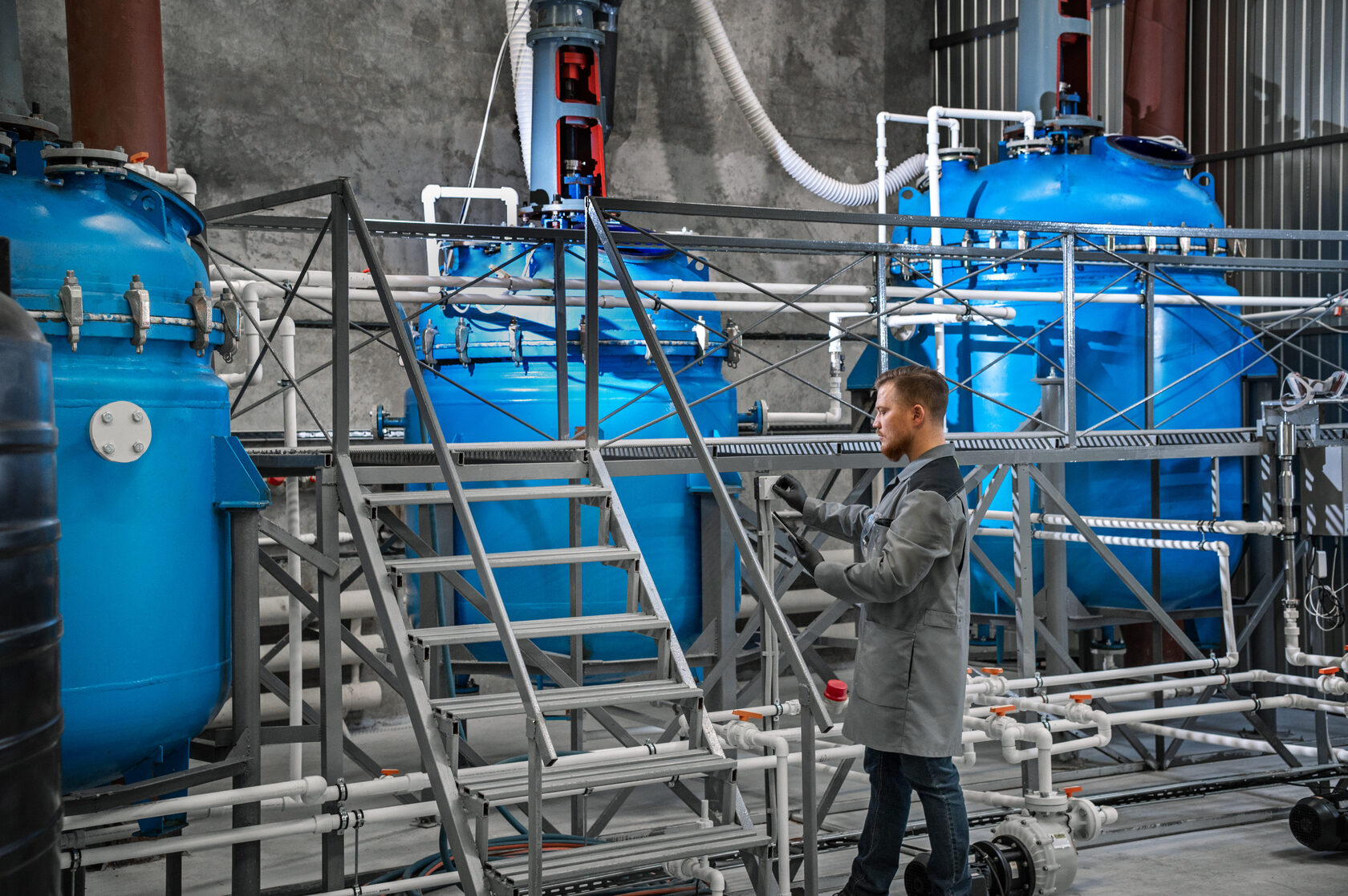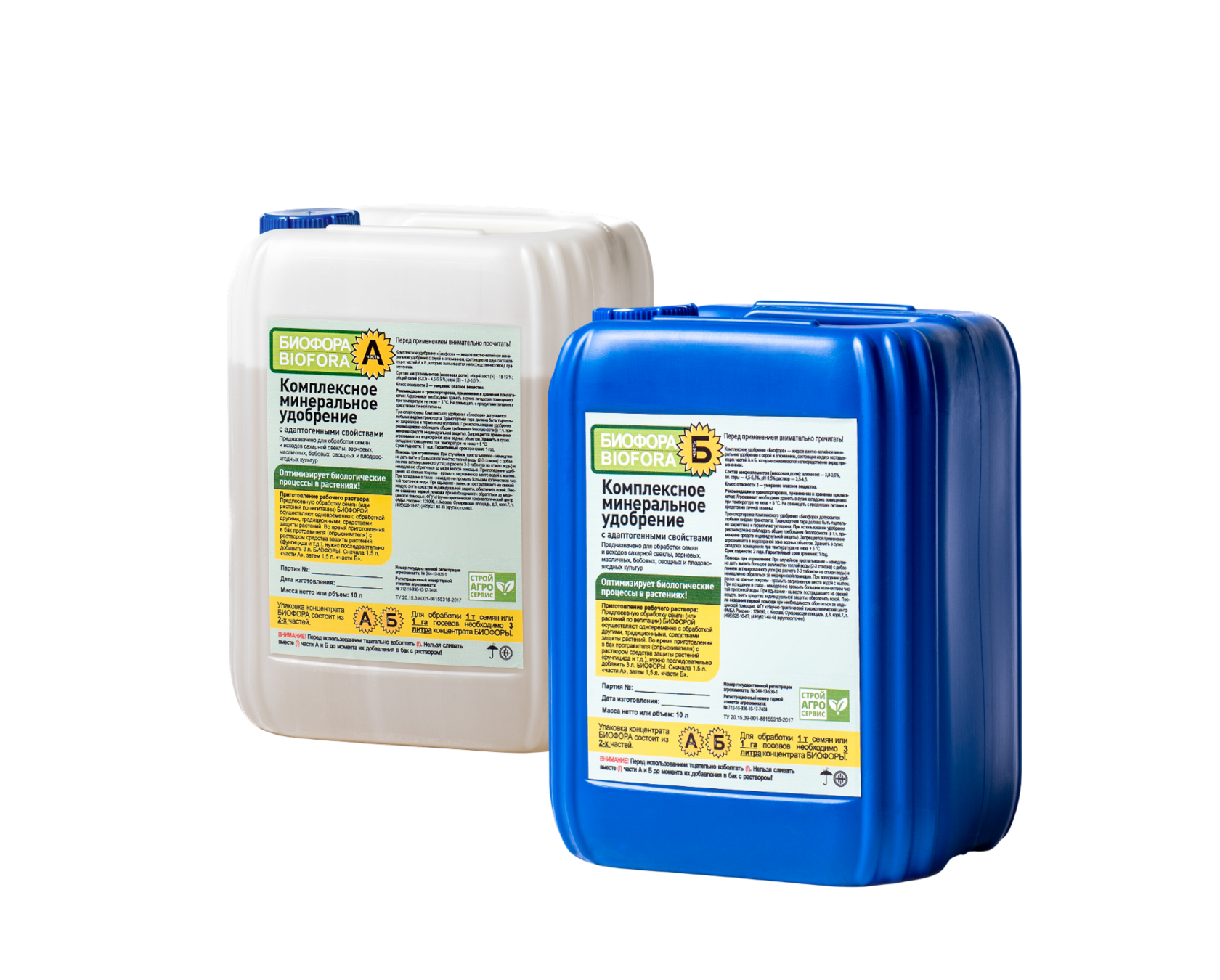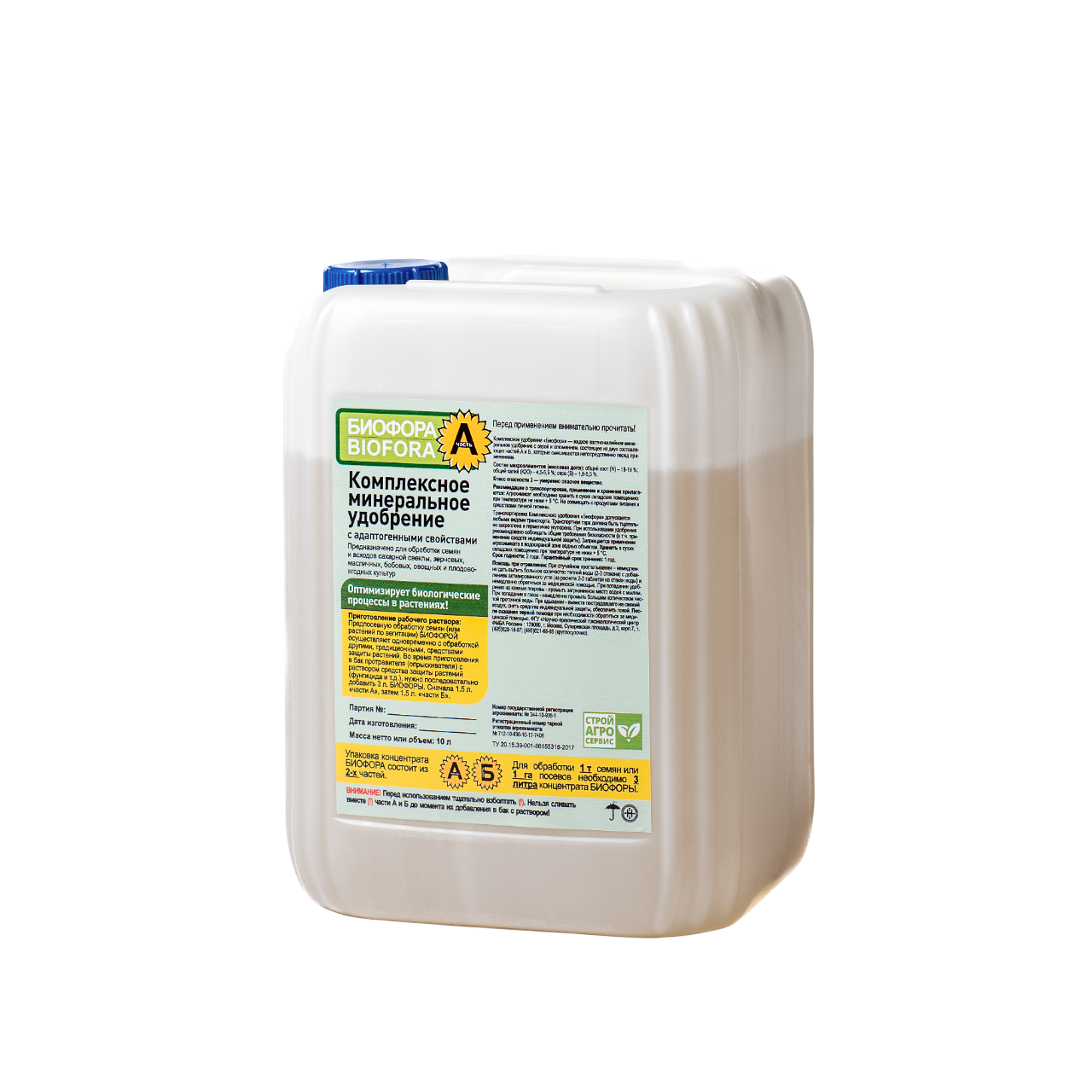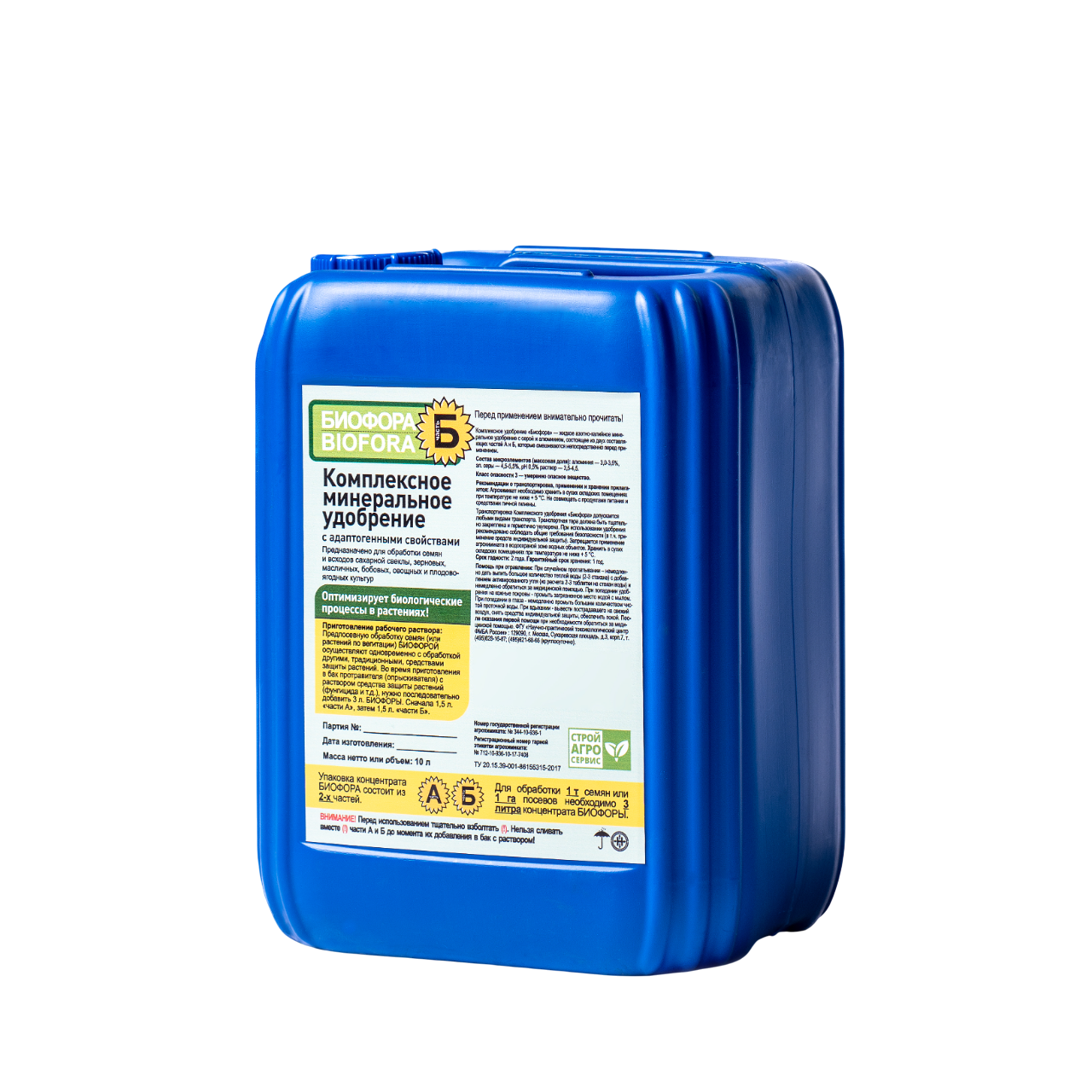Part Б contains:
total aluminum — 3,0–3,5% sulfur elements — 4,5–5,5%
ph — 3,5–4,5
ph — 3,5–4,5
total nitrogen (N) — 18–19%
total potassium (K2O) — 4,5–5,5% sulfur elements — 1,8–2,0%
ph — 6,5–7,1
total potassium (K2O) — 4,5–5,5% sulfur elements — 1,8–2,0%
ph — 6,5–7,1
Compound
Part A contains:
The complex fertilizer "Biofora" is used for treating seed material before sowing, soaking the root system of seedlings before planting in the ground and foliar treatment of plants by spraying during vegetation.
Universal complex mineral fertilizer "Биофора"
8 (905) 000-38-88
Complex fertilizer "Биофора": universal complex mineral fertilizer, which consists of a complex of nutrients in the composition of macro and microelements. The fertilizer has adaptogenic properties that manifest themselves in the adaptation of the plant organism to unfavorable hydrothermal weather conditions, adapts plants to frosts, droughts and over-watering and other conditions that go beyond those favorable for the development of the plant organism. It consists of part “A” and part “Б”, which are mixed immediately before use.
- Adaptation to drought and waterlogging
total nitrogen (N) — 18–19%
total potassium(K2O) — 4,5–5,5% sulfur elements — 1,8–2,0%
ph — 6,5–7,1
total potassium(K2O) — 4,5–5,5% sulfur elements — 1,8–2,0%
ph — 6,5–7,1
Part A contains:
general aluminum — 3,0–3,5% sulfur elements — 4,5–5,5%
ph — 3,5–4,5
ph — 3,5–4,5
Part Б contains:
- Optimizing nutrition when basic fertilizers are lacking
- Accelerated rehabilitation from pesticide pressure
- Resistance to heat and frost
Consumption rate
Application phase
Grape
Rape
Sunflower
Corn
Sugar beet
Soybeans, peas, chickpeas
1 l / 1 ha
2 l / 1 ha
2 l / ha
3 l / 1 ha
3 l / 1 ha
5 l / 1 ton
3 l / 1 ha
3 l / 1 ha
5 l / 1 ton
Processing in the milk ripeness phase
Processing in the pea phase
Fertilizing a week before flowering
Top dressing at the beginning of budding
Top dressing at the beginning of stem formation
Pre-sowing seed treatment
Top dressing at 5-7 pairs of leaves
Top dressing at 3-4 pairs of leaves
Pre-sowing seed treatment
3 l / 1 ha
3 l / 1 ha
3 l / 1 ton
3 l / 1 ha
3 l / 1 ha
3 l / 1 ton
3 l / 1 ha
3 l / 1 ha
3 l / 1 ha
3 l / 1 ha
3 l / 1 ton
3 l / 1 ton
Foliar feeding in the phase of appearance of 5-7 true leaves
Foliar feeding in the phase of appearance of 3-5 true leaves
Pre-sowing seed treatment
Top dressing before row spacing closes
Foliar feeding before rows close
Pre-sowing seed treatment
Processing at the beginning of bean formation
Foliar feeding in the phase of appearance of 3-5 true leaves
Pre-sowing seed treatment
Top dressing during the tube emergence phase
Top dressing during the tillering phase
Pre-sowing seed treatment
Winter/spring wheat, barley, rye, triticale, rice
Culture
*It is not allowed to mix Part A and Part Б without water.
Before use, part "A" and part "Б" must be shaken thoroughly. The resulting mixture is poured into the sprayer container of the seed dressing agent one by one*. The consumption rate of the working solution is 250-300 l/ha. When treating seeds 10 l/t. The solution must be prepared and the sprayer must be filled in specially equipped areas.
The complex fertilizer "Биофора" is used for treating seed material before sowing, soaking the root system of seedlings before planting in the ground and foliar treatment of plants by spraying during vegetation.
Cooking method
Norms and methods of application
Compound
Advantages
Purpose
Description


Among the most essential elements that play a vital role in the nutrition of agricultural crops, sulfur (S) occupies a special place. Although the amount of its consumption by plants is not so great compared to nitrogen, phosphorus and potassium, its importance for the full growth and development of crops is difficult to overestimate. In the plant organism, sulfur is present in the form of organic and mineral compounds and makes up about 0.2-1% of the dry mass of plants, but in terms of its biochemical effect it is equal to macronutrients. It is impossible to replace it with other elements of mineral nutrition. Sulfur deficiency is a pressing problem for a large number of lands in Russia*. According to the agrochemical service, only 10% of the country's arable lands are characterized by a high content of this macronutrient - more than 12 mg / kg, and 75% are deficient in it and require the use of sulfur-containing fertilizers.
Sulfur is actively involved in nitrogen and carbohydrate metabolism, in the processes of respiration and fat synthesis. It enhances the growth and development of plants, stimulates the formation of beneficial bacteria on plant roots, and intensifies the absorption activity of the root system, thereby increasing the efficiency of NPK fertilizers, promoting the mobilization of nutrients from the soil (calcium, magnesium, iron, microelements) and reducing the entry of radionuclides into plants. At the same time, an increase in the resistance of agricultural crops to unfavorable climatic conditions (high or low temperatures, drought) is noted. Sulfur in crops is an essential component of protein compounds (amino acids - methionine, cystine, cysteine), vitamins B1 (thiamine) and H (biotin), lipoic acid, glutathione, coenzyme A, sulfolipids, chlorophyll, therefore its deficiency causes disturbances in protein synthesis processes, leads to a decrease (up to 40%) in the intensity of the photosynthesis process and the accumulation of soluble nitrogen compounds (nitrites and nitrates). Sufficient supply of sulfur nutrition to plants is one of the conditions for obtaining high-quality crops. Sulfur ensures a high level of accumulation of sugars and starch in products, increases the oil content in rapeseed, sunflower, soybean seeds, and increases the proportion of gluten in wheat grain.
Sulfur, like nitrogen, plays an important role in protein synthesis, so there is a close relationship between plant nutrition with nitrogen and sulfur. It is known that with a low level of nitrogen nutrition, sulfur compounds are able to compensate for the lack of nitrogen in the plant. At the same time, if you feed plants with nitrogen in sufficient quantities, but they lack sulfur, they will not be able to absorb nitrogen.
*Проблема дефицита серы появилась недавно. Дело в том, что ещё в прошлом веке в воздухе было много серы в виде сернистого газа. Это объяснялось интенсивным использованием в промышленности каменного угля, при сгорании которого в атмосферу выделялись газы, содержащие серу. Потом они, смешиваясь с водой, выпадали на землю так называемыми кислотными дождями. А поскольку такие осадки были признаны одной из глобальных экологических проблем, то мировая промышленность переориентировалась на другие источники энергии.
Sulfur is actively involved in nitrogen and carbohydrate metabolism, in the processes of respiration and fat synthesis. It enhances the growth and development of plants, stimulates the formation of beneficial bacteria on plant roots, and intensifies the absorption activity of the root system, thereby increasing the efficiency of NPK fertilizers, promoting the mobilization of nutrients from the soil (calcium, magnesium, iron, microelements) and reducing the entry of radionuclides into plants. At the same time, an increase in the resistance of agricultural crops to unfavorable climatic conditions (high or low temperatures, drought) is noted. Sulfur in crops is an essential component of protein compounds (amino acids - methionine, cystine, cysteine), vitamins B1 (thiamine) and H (biotin), lipoic acid, glutathione, coenzyme A, sulfolipids, chlorophyll, therefore its deficiency causes disturbances in protein synthesis processes, leads to a decrease (up to 40%) in the intensity of the photosynthesis process and the accumulation of soluble nitrogen compounds (nitrites and nitrates). Sufficient supply of sulfur nutrition to plants is one of the conditions for obtaining high-quality crops. Sulfur ensures a high level of accumulation of sugars and starch in products, increases the oil content in rapeseed, sunflower, soybean seeds, and increases the proportion of gluten in wheat grain.
Sulfur, like nitrogen, plays an important role in protein synthesis, so there is a close relationship between plant nutrition with nitrogen and sulfur. It is known that with a low level of nitrogen nutrition, sulfur compounds are able to compensate for the lack of nitrogen in the plant. At the same time, if you feed plants with nitrogen in sufficient quantities, but they lack sulfur, they will not be able to absorb nitrogen.
*Проблема дефицита серы появилась недавно. Дело в том, что ещё в прошлом веке в воздухе было много серы в виде сернистого газа. Это объяснялось интенсивным использованием в промышленности каменного угля, при сгорании которого в атмосферу выделялись газы, содержащие серу. Потом они, смешиваясь с водой, выпадали на землю так называемыми кислотными дождями. А поскольку такие осадки были признаны одной из глобальных экологических проблем, то мировая промышленность переориентировалась на другие источники энергии.
2.Sulfur
There is an opinion that aluminum is a toxic element for all plants. This is fundamentally wrong! Aluminum is actively involved in the physiological processes of plants. Aluminum is a necessary element for the formation of proteins, enzymes and hormones that are necessary for the normal growth and development of plants. Due to the presence of aluminum, the Biofora fertilizer helps strengthen the immune system of plants, increases their resistance to diseases and pests, and has a positive effect on the growth of the root system of plants. It also stimulates the formation of new roots, improves their quality and promotes the absorption of important nutrients. Aluminum helps plants effectively absorb moisture from the soil, which helps strengthen their resistance to unfavorable growth conditions. In addition, aluminum has a positive effect on the physical properties of the soil, improving its structure and water permeability.
3.Aluminum
- Биофора contains a nitrification inhibitor*
As is known, plants absorb and assimilate nitrogen from fertilizers in two forms: ammonium and nitrate. The nitrate form, which is highly mobile in the soil, is assimilated more easily - it moves with the transpiration flow of water from the soil to the plant. The absorption of ammonium nitrogen occurs only in the immediate vicinity of the root. And when one unit of ammonium nitrogen is absorbed, the root releases one proton (H+) into the soil solution to prevent acidification of the cell cytoplasm.
How a nitrification inhibitor works: The positively charged ammonium form of nitrogen (NH4+) is easily converted to nitrate (N03-) through a process called nitrification. The nitrate form (N03-) is most quickly consumed by plants, but is subject to rapid leaching from the soil and denitrification, with subsequent loss of nitrogen in the form of gaseous compounds (NO, N2O, N2). The inhibitor macromolecule has a strong negative charge and attracts ammonium nitrogen cations (NH4+). The nitrification process - the transition of NH4 to NO3 - stops. The plant gradually absorbs NH4 through its growing root system. No losses occur in the form of NH3 (gas) evaporation, NO3 leaching or denitrification. The use of nitrification inhibitors forces crops to absorb ammonium nitrogen after nitrates have been depleted in the soil. Ammonium nitrogen has a positive effect on protein biosynthesis, since ammonium is one of the main components of amino acids and proteins. When absorbing only nitrate nitrogen, the culture has to spend about 20 moles of ATP (units of biological energy) per mole of nitrate nitrogen so that during the process of biosynthesis in the cell it is converted first into ammonium nitrogen and only then into amino acids. When ammonium nitrogen is absorbed, the amount of energy required for biosynthesis is reduced to 5 mol of ATP. This difference allows the crop to produce a higher yield and improve its quality. In addition, due to the release of protons into the rhizosphere during ammonium absorption, the availability of certain nutrients, such as phosphorus and microelements, to plants increases.
Slowing down nitrification with inhibitors provides a number of advantages that help increase the efficiency of fertilizers:
— losses from nitrate leaching are reduced. They are especially high when there is a large amount of precipitation during the growing season.
— nitrogen losses in the form of gases (N2O, NO) are reduced.
— ammonium fertilization of crops has a positive physiological effect on crop growth. The degree of nitrogen absorption increases, which allows the crop to produce a higher yield and improve its quality.
— allows higher doses of nitrogen to be applied without the risk of its excess being converted into nitrates.
Nitrification inhibitors not only stimulate an increase in crop yields, but also save our ecology, since one of their purposes is to reduce the rate of application of nitrogen fertilizers. As a result of nitrate leaching, water bodies are polluted. Reducing nitrogen emissions in the form of greenhouse gas N2O or ozone-destroying gas NO to almost zero makes it possible to make the use of fertilizers environmentally safe in terms of the impact on global climate change..
*Nitrification inhibitors are added only to granulated fertilizers, which in turn cannot be called complex, since they contain only macroelements. Liquid fertilizers are more mobile, and therefore more nutritious for plants than granulated ones, and they can also be used for foliar feeding (on the leaf), which is impossible to do with granulated fertilizer.
How a nitrification inhibitor works: The positively charged ammonium form of nitrogen (NH4+) is easily converted to nitrate (N03-) through a process called nitrification. The nitrate form (N03-) is most quickly consumed by plants, but is subject to rapid leaching from the soil and denitrification, with subsequent loss of nitrogen in the form of gaseous compounds (NO, N2O, N2). The inhibitor macromolecule has a strong negative charge and attracts ammonium nitrogen cations (NH4+). The nitrification process - the transition of NH4 to NO3 - stops. The plant gradually absorbs NH4 through its growing root system. No losses occur in the form of NH3 (gas) evaporation, NO3 leaching or denitrification. The use of nitrification inhibitors forces crops to absorb ammonium nitrogen after nitrates have been depleted in the soil. Ammonium nitrogen has a positive effect on protein biosynthesis, since ammonium is one of the main components of amino acids and proteins. When absorbing only nitrate nitrogen, the culture has to spend about 20 moles of ATP (units of biological energy) per mole of nitrate nitrogen so that during the process of biosynthesis in the cell it is converted first into ammonium nitrogen and only then into amino acids. When ammonium nitrogen is absorbed, the amount of energy required for biosynthesis is reduced to 5 mol of ATP. This difference allows the crop to produce a higher yield and improve its quality. In addition, due to the release of protons into the rhizosphere during ammonium absorption, the availability of certain nutrients, such as phosphorus and microelements, to plants increases.
Slowing down nitrification with inhibitors provides a number of advantages that help increase the efficiency of fertilizers:
— losses from nitrate leaching are reduced. They are especially high when there is a large amount of precipitation during the growing season.
— nitrogen losses in the form of gases (N2O, NO) are reduced.
— ammonium fertilization of crops has a positive physiological effect on crop growth. The degree of nitrogen absorption increases, which allows the crop to produce a higher yield and improve its quality.
— allows higher doses of nitrogen to be applied without the risk of its excess being converted into nitrates.
Nitrification inhibitors not only stimulate an increase in crop yields, but also save our ecology, since one of their purposes is to reduce the rate of application of nitrogen fertilizers. As a result of nitrate leaching, water bodies are polluted. Reducing nitrogen emissions in the form of greenhouse gas N2O or ozone-destroying gas NO to almost zero makes it possible to make the use of fertilizers environmentally safe in terms of the impact on global climate change..
*Nitrification inhibitors are added only to granulated fertilizers, which in turn cannot be called complex, since they contain only macroelements. Liquid fertilizers are more mobile, and therefore more nutritious for plants than granulated ones, and they can also be used for foliar feeding (on the leaf), which is impossible to do with granulated fertilizer.
The drug "Биофора" promotes earlier emergence of seedlings, increases growth energy, stimulates the development of a powerful root system

Safety of the drug
The safety of the drug and its application to the natural environment have been confirmed by toxicological and environmental assessments.
Compatible with most preparations, it can be used in tank mix
02
Non-flammable
04
Non-toxic
03
Explosion proof
01
Moderately hazardous substance










